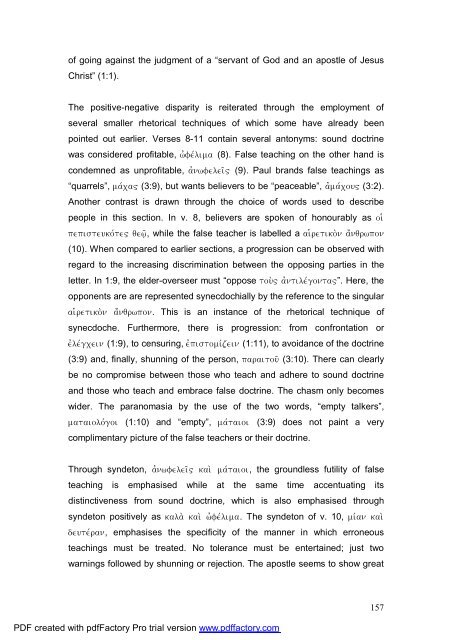A Text centred rhetorical analysis of Paul's Letter to Titus
A Text centred rhetorical analysis of Paul's Letter to Titus
A Text centred rhetorical analysis of Paul's Letter to Titus
Create successful ePaper yourself
Turn your PDF publications into a flip-book with our unique Google optimized e-Paper software.
<strong>of</strong> going against the judgment <strong>of</strong> a “servant <strong>of</strong> God and an apostle <strong>of</strong> Jesus<br />
Christ” (1:1).<br />
The positive-negative disparity is reiterated through the employment <strong>of</strong><br />
several smaller <strong>rhe<strong>to</strong>rical</strong> techniques <strong>of</strong> which some have already been<br />
pointed out earlier. Verses 8-11 contain several an<strong>to</strong>nyms: sound doctrine<br />
was considered pr<strong>of</strong>itable, wjfevlima (8). False teaching on the other hand is<br />
condemned as unpr<strong>of</strong>itable, ajnwfelei`" (9). Paul brands false teachings as<br />
“quarrels”, mavca" (3:9), but wants believers <strong>to</strong> be “peaceable”, ajmavcou" (3:2).<br />
Another contrast is drawn through the choice <strong>of</strong> words used <strong>to</strong> describe<br />
people in this section. In v. 8, believers are spoken <strong>of</strong> honourably as oiJ<br />
pepisteukovte" qew`/, while the false teacher is labelled a aiJretiko;n a[nqrwpon<br />
(10). When compared <strong>to</strong> earlier sections, a progression can be observed with<br />
regard <strong>to</strong> the increasing discrimination between the opposing parties in the<br />
letter. In 1:9, the elder-overseer must “oppose <strong>to</strong>u;" ajntilevgonta"”. Here, the<br />
opponents are are represented synecdochially by the reference <strong>to</strong> the singular<br />
aiJretiko;n a[nqrwpon. This is an instance <strong>of</strong> the <strong>rhe<strong>to</strong>rical</strong> technique <strong>of</strong><br />
synecdoche. Furthermore, there is progression: from confrontation or<br />
ejlevgcein (1:9), <strong>to</strong> censuring, ejpis<strong>to</strong>mivzein (1:11), <strong>to</strong> avoidance <strong>of</strong> the doctrine<br />
(3:9) and, finally, shunning <strong>of</strong> the person, parai<strong>to</strong>u` (3:10). There can clearly<br />
be no compromise between those who teach and adhere <strong>to</strong> sound doctrine<br />
and those who teach and embrace false doctrine. The chasm only becomes<br />
wider. The paranomasia by the use <strong>of</strong> the two words, “empty talkers”,<br />
mataiolovgoi (1:10) and “empty”, mavtaioi (3:9) does not paint a very<br />
complimentary picture <strong>of</strong> the false teachers or their doctrine.<br />
Through synde<strong>to</strong>n, ajnwfelei`" kai; mavtaioi, the groundless futility <strong>of</strong> false<br />
teaching is emphasised while at the same time accentuating its<br />
distinctiveness from sound doctrine, which is also emphasised through<br />
synde<strong>to</strong>n positively as kala; kai; wjfevlima. The synde<strong>to</strong>n <strong>of</strong> v. 10, mivan kai;<br />
deutevran, emphasises the specificity <strong>of</strong> the manner in which erroneous<br />
teachings must be treated. No <strong>to</strong>lerance must be entertained; just two<br />
warnings followed by shunning or rejection. The apostle seems <strong>to</strong> show great<br />
PDF created with pdfFac<strong>to</strong>ry Pro trial version www.pdffac<strong>to</strong>ry.com<br />
157

















